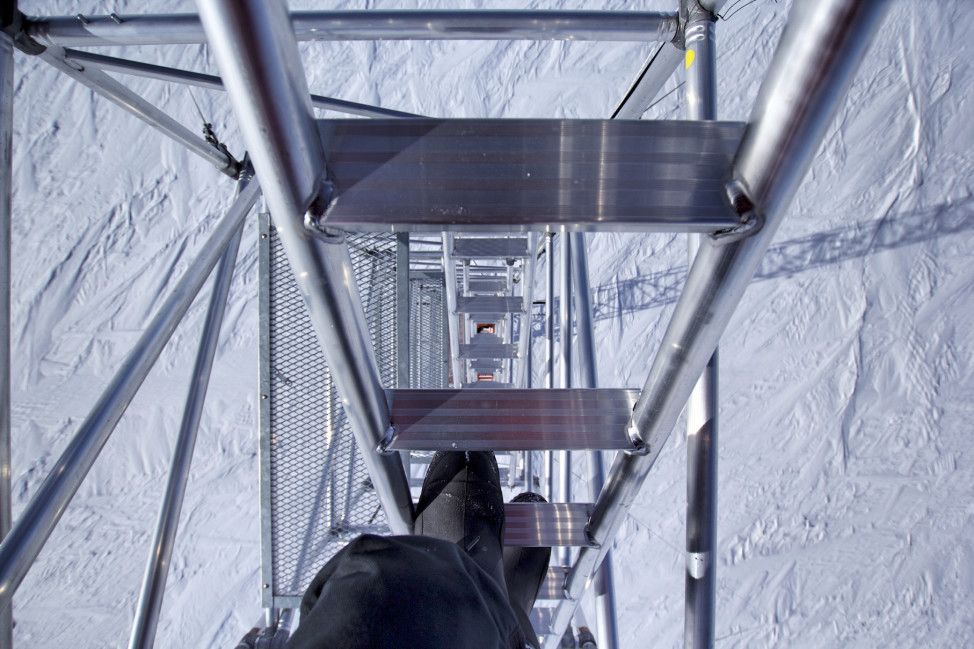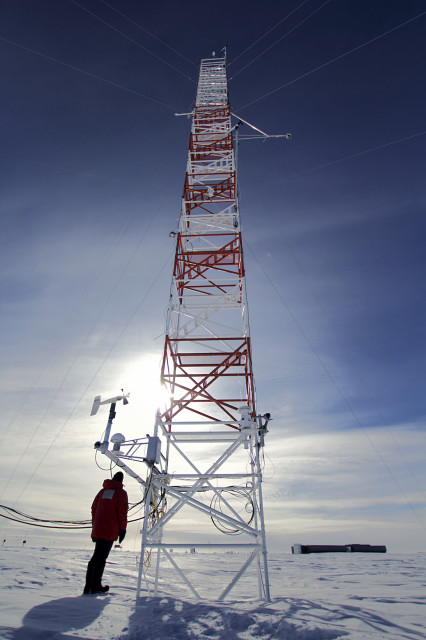
It’s a steep climb from the bottom of the tower to the top. (Photo by Hunter Davis)
Yesterday, it was minus 34 Celsius (minus 29 Fahrenheit) and sunny.
Winds were low and visibility was perfect. The sky was a uniform shade of blue, stretching from horizon to horizon like a taut canvas. Walking to work, I felt like a red line running down the middle of a Barnett Newman painting. I was an interloper in an otherwise still scene.
SOUTH POLE JOURNAL
Refael Klein is blogging about his experiences as he spends a year working and living at the South Pole. Read his earlier posts here.

Refael Klein at the base of the tower inspecting the electrical and air hose connections. (Photo by Hunter Davis)
Every movement I made felt accentuated and unnatural. Ice cracked and hissed with each step of my heavy, green, insulated rubber boots, its voice growing louder and louder until it was deafening, and there was nothing left for me to do but stand still and admire the desolation of the landscape.
It is rare to have South Pole days like these, especially in early summer. The winter is never more than a few moments away. At the flick of a wrist, the temperature can drop 30 degrees and the wind can carry away visibility with cyclones of snow.
We make the most of the conditions whenever it is stable and “warm”, and try to dedicate part of our day to working on outside tasks that would otherwise be too difficult or too dangerous to accomplish.
At the Atmospheric Research Observatory (ARO), this could mean setting up new solar radiation equipment on our rooftop, raising electrical runs on the outside of the building, or inspecting instrumentation on our meteorological tower.
Given the sheer beauty of the day, we decided to go climbing.
ARO’s meteorological tower is 30 meters (100 feet) tall. Built out of red-and-white, Erector-set-like pieces of steel, it is anchored to the ground with over a dozen woven steel guy-lines.
A ladder well running through the middle switchbacks so tightly from bottom to top that, as you ascend, you feel like an ant walking up the threads of a screw.

Instruments at the top of the tower: wind bird (top left), temperature detector (top right), aspirated air intake (bottom). On a clear day, you can see out over 10 miles from the top of the meteorological tower. (Photo by Hunter Davis)
Wind birds, temperature detectors, humidity probes, albedo sensors and air intakes for instruments inside the station run along the length of the tower. Even though the equipment is robust, it’s important to check on it regularly to ensure that everything’s working properly and not malfunctioning in a way that impacts data quality.
I dress warmly before leaving the station, filling my pockets with an assortment of basic tools in case I need to repair, re-level or take down a broken instrument.
As I climb upwards, the all-metal tower sucks heat away from my hands and feet and, by the time I’m half-way up, I’m uncomfortably cold.
At the top of the tower, an aspirator on one of our intake lines doesn’t sound like it’s spinning. I get down on my knees and roll the right side of my windproof hat up so I can place my ear next to the fan’s plastic protective backing for a better listen.
It is hard to tell if the fan is humming along, or if it’s just my ear ringing from the brutal cold, so I take off my mittens and wearing only thin liner gloves, begin to undo a series of thumb screws that will allow me to remove the housing and visually verify things. It takes me less than a minute to do so. Everything is working fine.
I shove my numb fingers back into my mittens and rush down the tower, hoping I can make it to the bottom before my fingers begin to burn and swell with new blood.
Look for Refael Klein’s weekly blogs from the South Pole here on Science World.






















Interestingstuff!!!>J
Great writing and article. I thoroughly enjoyed reading his unique experiences. What a place! How many are there of you out there?
— Sincerely, Dr. M.
Dr. Melville,
Thanks for the positive feedback. We will average about 145 people on station through the Summer, (November-January). By the middle of February, when the winter season begins, our population will drop to somewhere between 40 and 50.
I hope a lot of your residential spaces are underground (under snow as it were). Easier to heat and less radiation and convection loss to wind…..and quieter and safer.
Man-made “climate change” is largely a myth promoted by politicians to scare the public into accepting a vast expansion of government to supposedly stop “global warming.”
Global warming is a manufactured problem played up by the government to instigate a public reaction – fear – the government then exploits to offer a predetermined solution: the expansion of government at the public’s expense.
This strategy, now known as the Hegelian Dialectic, has been used successfully by politicians for millennia to expand government, which can only grow at the expense of individual liberties.
The Bush administration used the strategy successfully in 2003 when it gained enough public support for the invasion of Iraq by claiming the country had weapons of mass destruction, and the war ultimately expanded the military-industrial complex and America’s emerging police state.
Today “global warming” is used as the bogey man because it allows the United Nations to scare the world’s population into believing “man-made climate change” is too big of a threat for their country to handle alone and thus it can only be “defeated” through the expansion of the U.N. at the expense of their nation’s sovereignty.
And state-funded scientists are given thousands and even millions of dollars to help promote the myth of “global warming” by fitting their data into the fearmongering agenda.